
AP
®
BIOLOGY
2012 SCORING GUIDELINES
© 2012 The College Board.
Visit the College Board on the Web: www.collegeboard.org.
Question 3
Note: At least 1 point must be earned from each of parts (a), (b), (c), and (d) in order to earn a maxim
um
score of 10.
Information flow in cells can be regulated by various mechanisms.
(a) Describe the role of THREE of the following in the regulation of protein synthesis:
• RNA splicing
• repressor proteins
• methylation
• siRNA
(3 points maximum)
Description (1 point per box)
RNA splicing
• Exons spliced together.
• Introns removed.
• snRNPs/spliceosomes help remove introns.
Repressor proteins
• Inhibit transcription.
• Inhibit translation.
• Silence genes.
• Inactivate gene expression.
Methylation
• DNA or histone methylation prevents transcription.
• Protects against restriction enzymes.
siRNA
• Facilitates degradation of mRNA.
• Inhibits translation.

AP
®
BIOLOGY
2012 SCORING GUIDELINES
© 2012 The College Board.
Visit the College Board on the Web: www.collegeboard.org.
Question 3 (continued)
(b) Information flow can be altered by mutation. Describe THREE different types of mutations and their
effect on protein synthesis.
(4 points maximum)
Type of mutation
(not limited to the
following) Description (1 point per box) Effect (1 point per box)
Silent Nucleotide change. No change in amino
acid/protein sequence.
Missense/substitution Nucleotide change causes new
codon.
Different amino acid/protein
sequence.
Nonsense/substitution Nucleotide change causes stop
codon.
Protein not formed OR
truncated protein.
Frameshift
(insertion/deletion)
Nucleotide insertion/deletion alters
reading fram
e after mutation.
Changes amino acid/protein
sequence OR nonfunctional
protein OR no protein.
Regulatory region Nucleotide
insertion/deletion/substitution.
Alters gene expression OR
alters splice site.
Translocation Chromosome segment moves to
different site.
Nondisjunction Chromosomes fail to separate.
Duplication
Deletion
Chromosome segment doubles.
Chromosome segment is removed.
Alters gene expression.
Inversion Chromosome segment is reversed.
Transposition Chromosome segment moves to a
different site.
(c) Identify TWO environmental factors that increase the mutation rate in an organism, and discuss
their effect on the genome of the organism.
(4 points maximum)
Environmental factor (not limited to the
following) (1 point each; 2 points maximum)
• UV light
• Carcinogens
• Cigarette smoke
• Asbestos
• Radon gas
• Radiation
• X-rays
• Gamma rays/cosmic rays
• Chemical mutagens
• Nitrites
• EtBr
• Aflatoxin
• Pollution
• Viruses
Discussion (1 point each; 2 points
maximum)
• T-T/thymine dimers.
• DNA is altered/damaged
(e.g., deamination, depurination, double
strand breaks).
• Disrupt gene sequence.
AP
®
BIOLOGY
2012 SCORING GUIDELINES
© 2012 The College Board.
Visit the College Board on the Web: www.collegeboard.org.
Question 3 (continued)
(d) Epigenetics is the study of heritable changes in the phenotype caused by mechanisms other than
changes in the DNA sequence.
Describe ONE example of epigenetic inheritance.
(1 point maximum)
Description of an epigenetic example (1 point maximum)
Acceptable responses include, but are not limited to, the following:
• DNA or histone modifications
• Inactivated X chromosomes (Barr bodies, calico cats)
• Heterochromatin
• Tumor suppressor genes (inactivation of p53)
• Cellular aging
• Environmental/in utero influences
• Maternal diet
• Agouti mice
• Heavy metals
• Famine study
• Pollution
• Twin studies (e.g., identical twin variations)
• Stress-induced alterations (e.g., post-traumatic stress disorder)
• Genomic imprinting (e.g., Prader-Willi syndrome, Angelman syndrome)
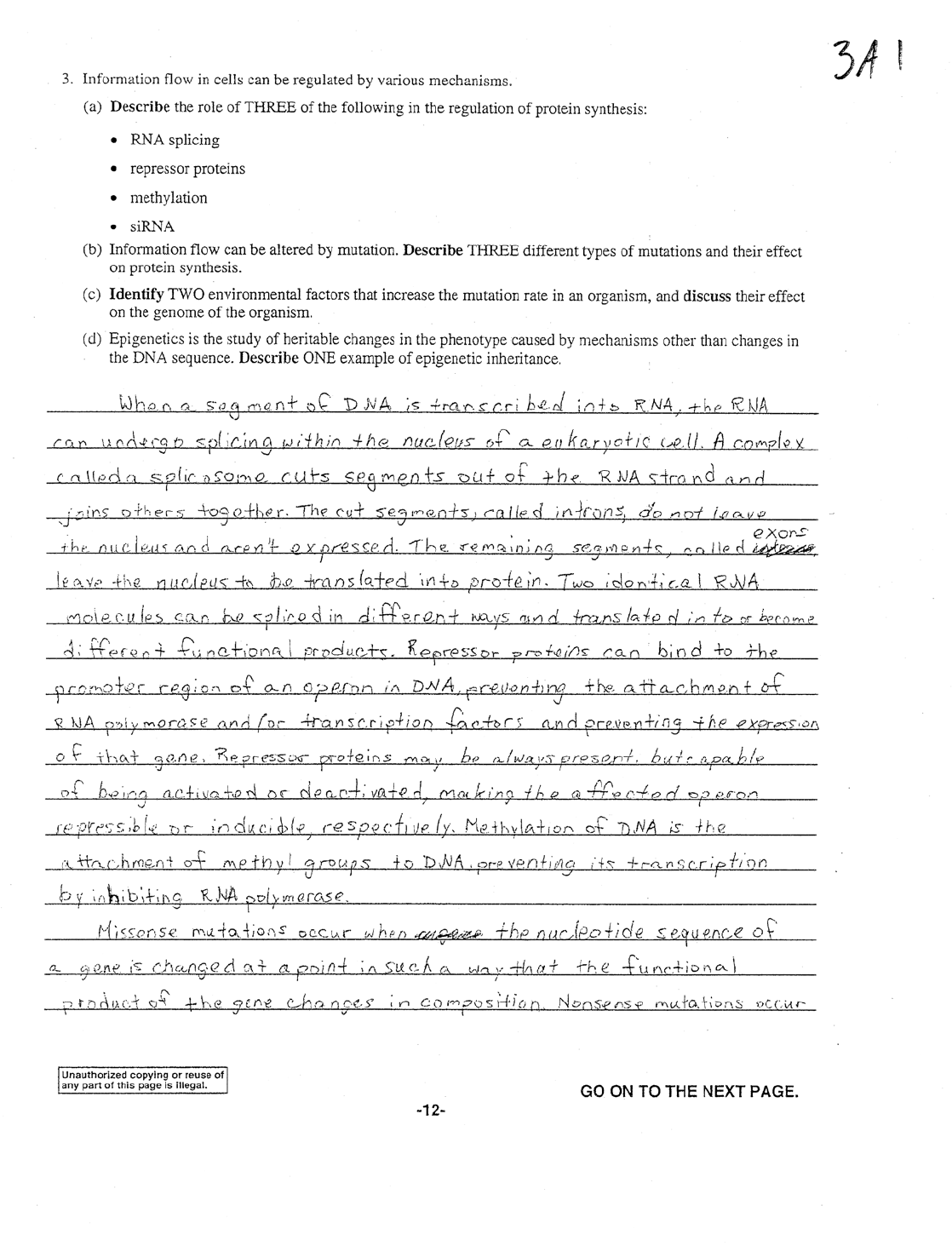
© 2012 The College Board.
Visit the College Board on the Web: www.collegeboard.org.
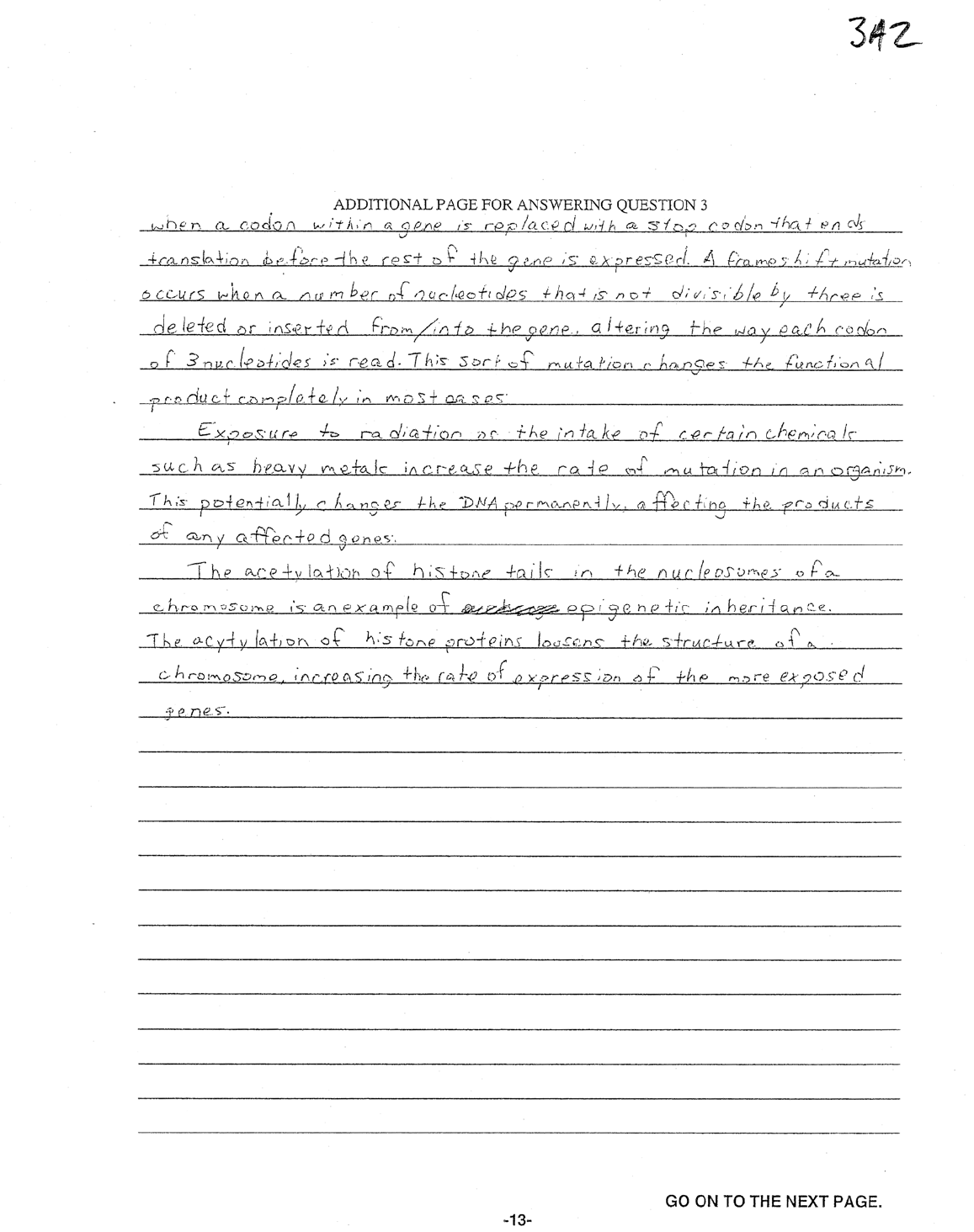
© 2012 The College Board.
Visit the College Board on the Web: www.collegeboard.org.
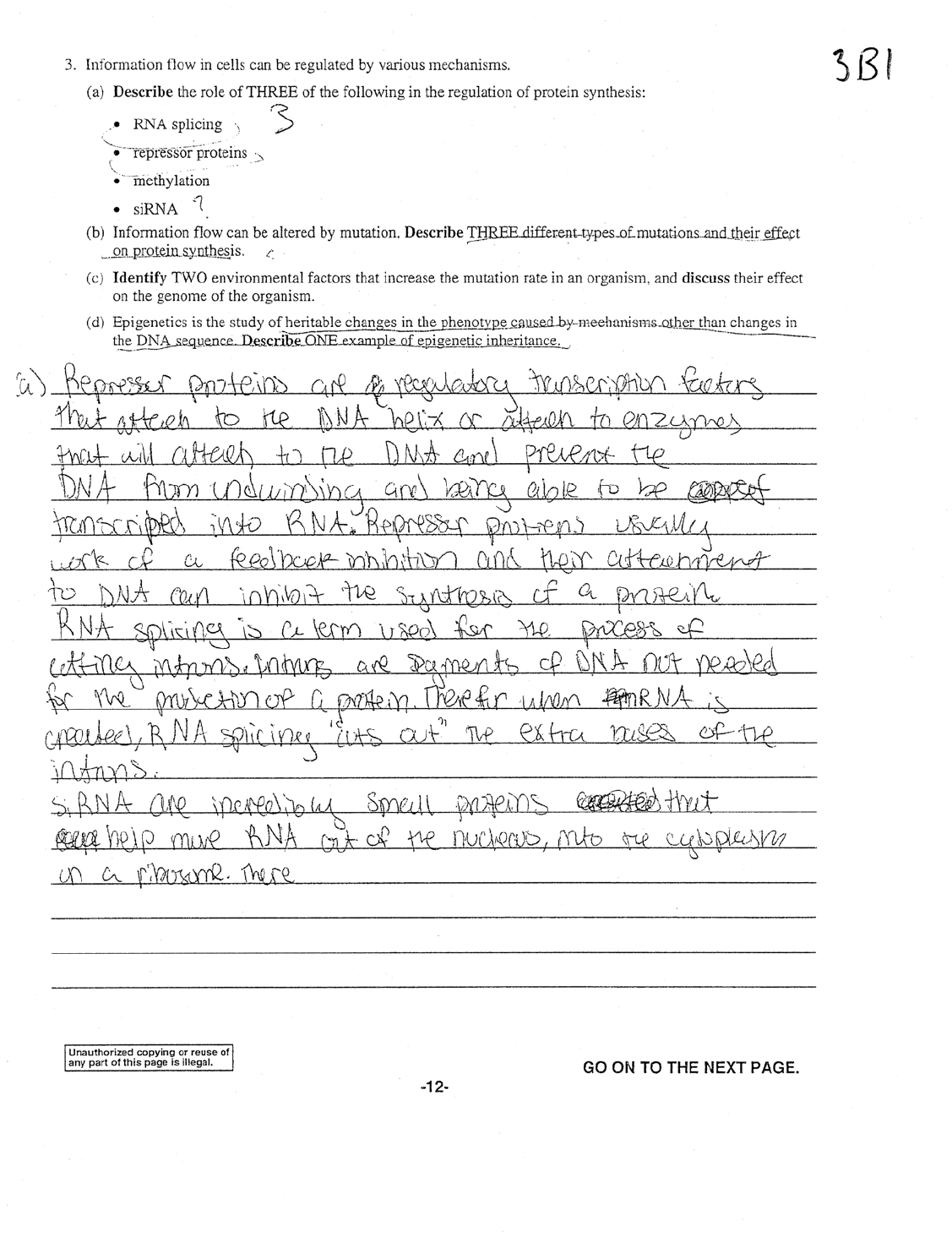
© 2012 The College Board.
Visit the College Board on the Web: www.collegeboard.org.
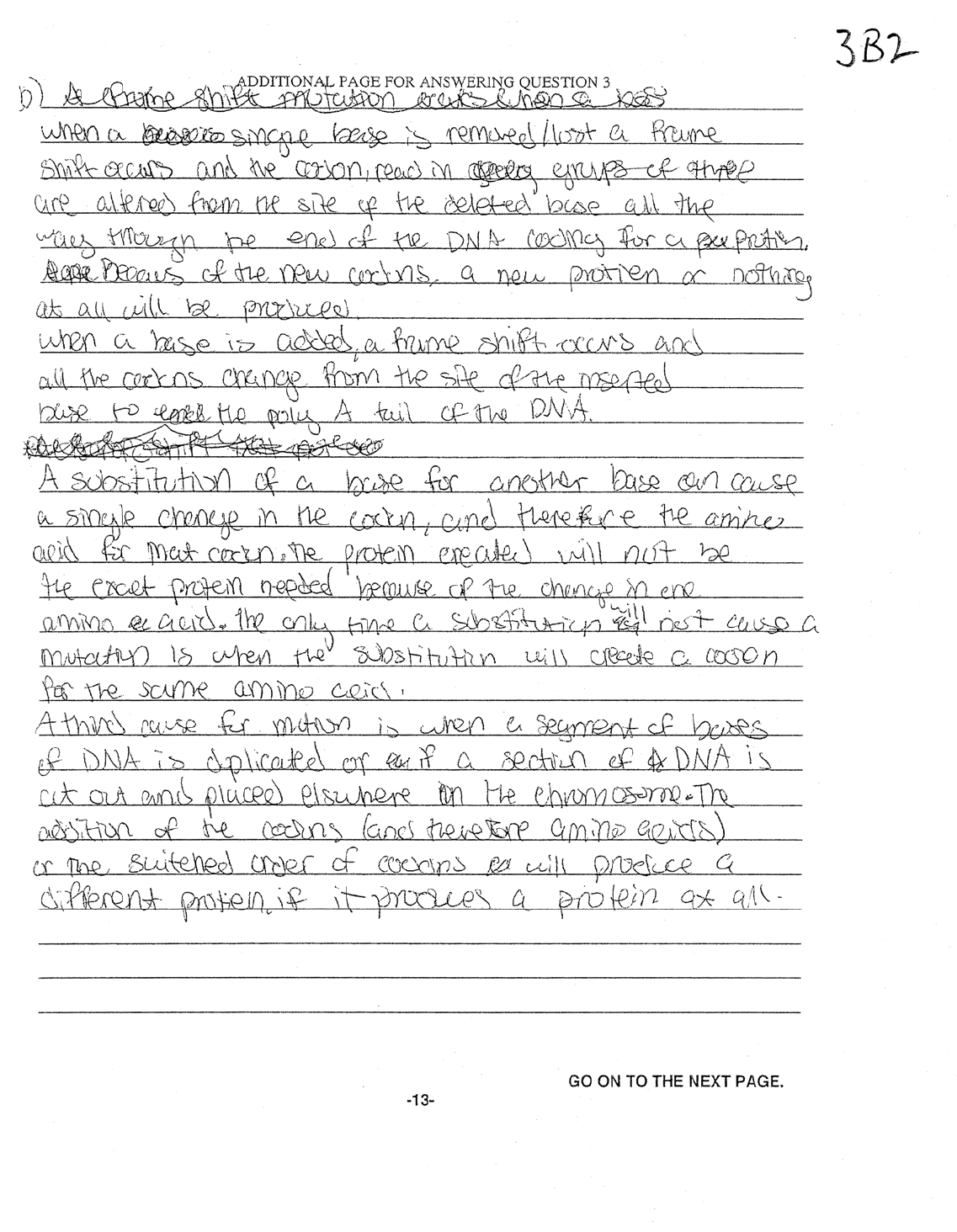
© 2012 The College Board.
Visit the College Board on the Web: www.collegeboard.org.
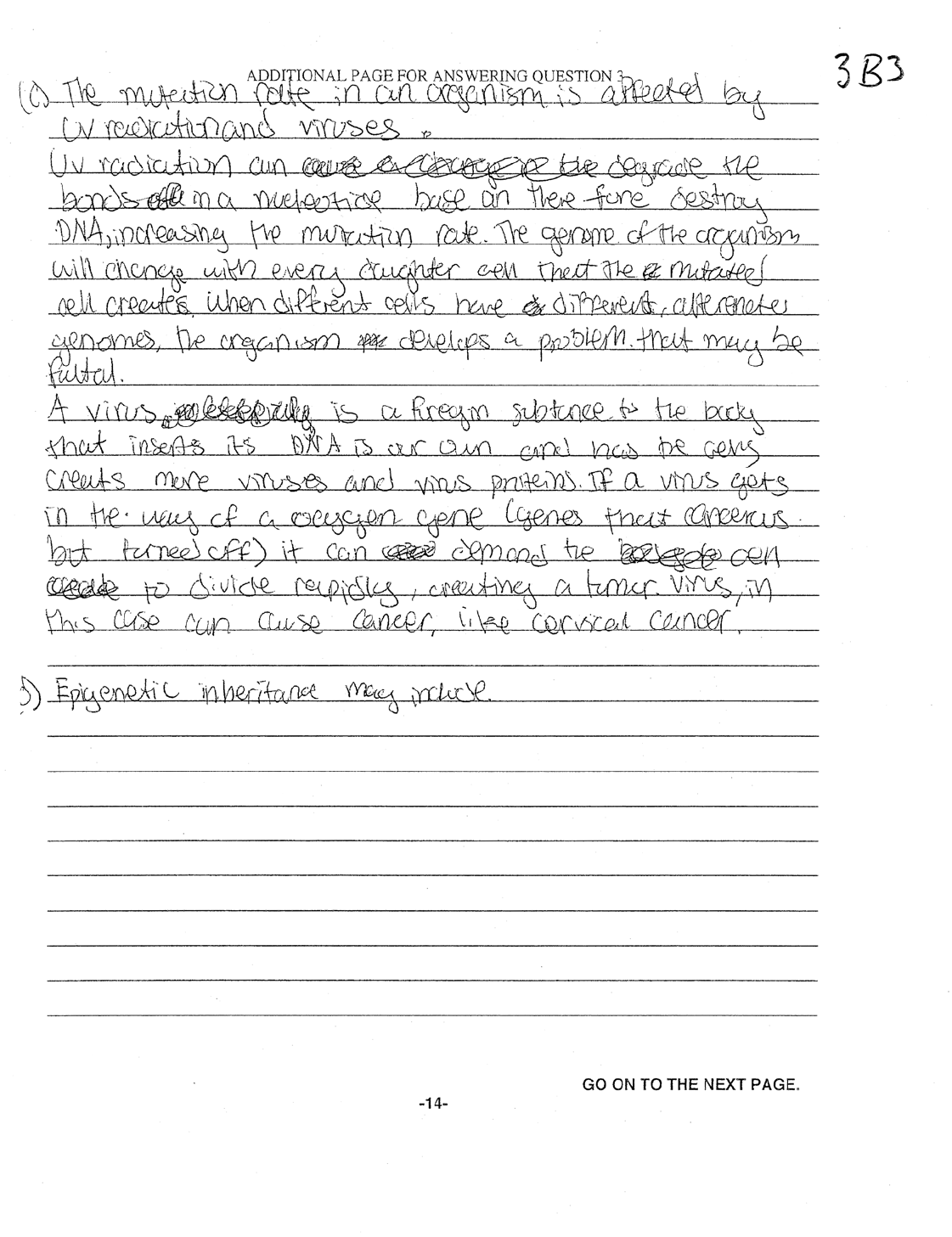
© 2012 The College Board.
Visit the College Board on the Web: www.collegeboard.org.
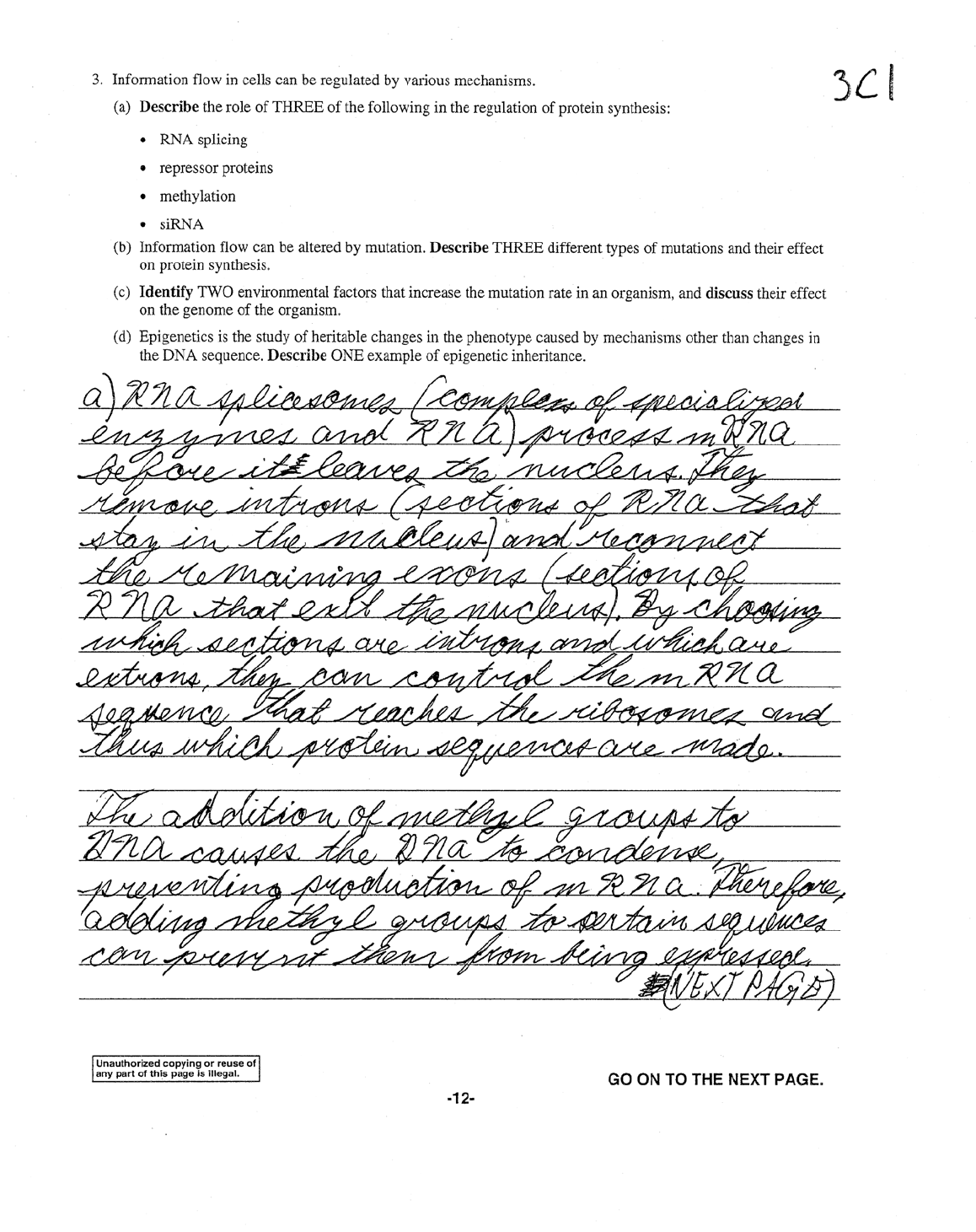
© 2012 The College Board.
Visit the College Board on the Web: www.collegeboard.org.
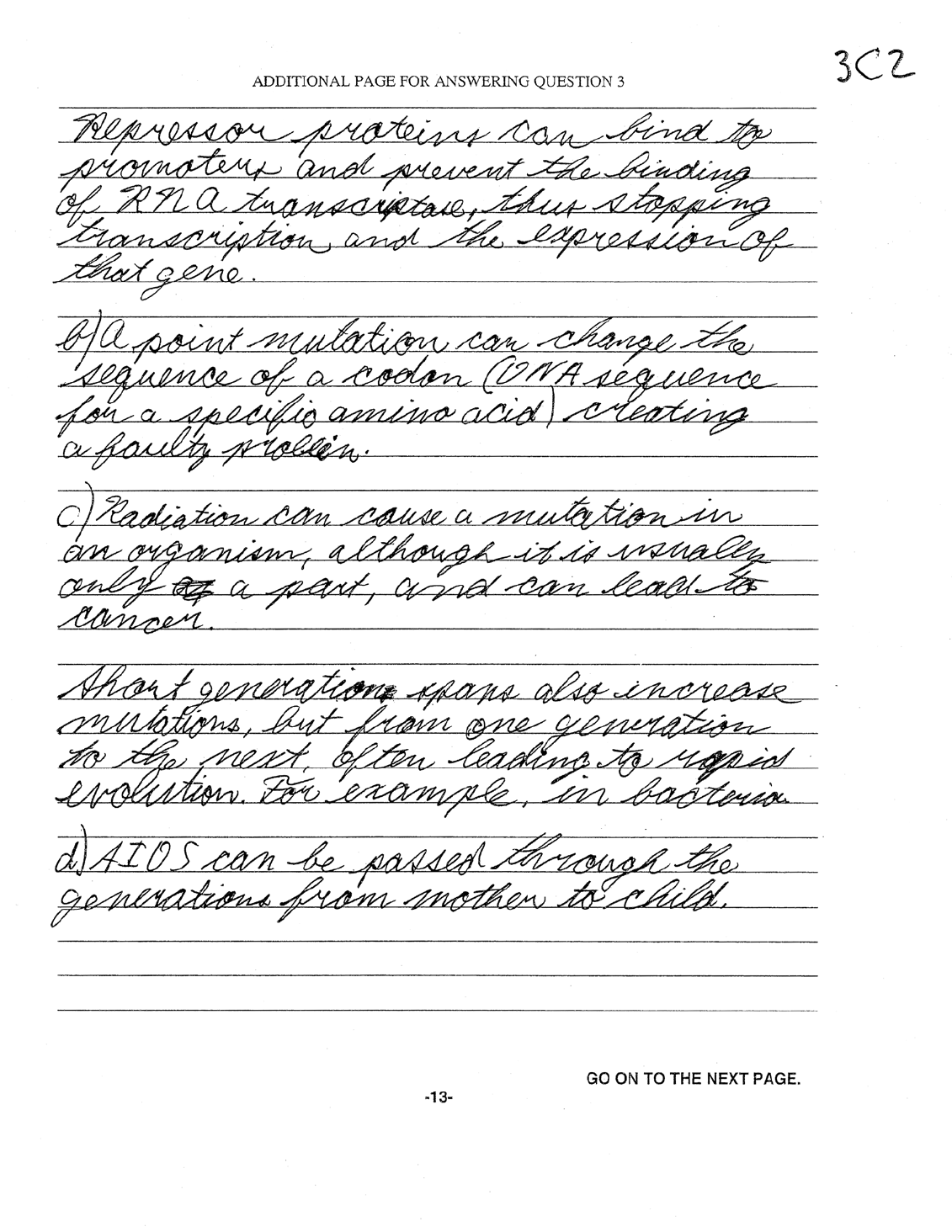
© 2012 The College Board.
Visit the College Board on the Web: www.collegeboard.org.
AP
®
BIOLOGY
2012 SCORING COMMENTARY
Question 3
Overview
This question asked students to describe information flow within cells and organisms — specifically, the
regulation of, and the effects of mutations on, protein synthesis. Part (a) required students to describe the
role of three normal cellular processes or factors in the regulation of protein synthesis, and part (b) asked for
a description of three different types of mutations and the effect of the mutations on protein synthesis. In
part (c) students were requested to identify environmental factors that could increase the mutation rate
and to describe the effect of these mutations on the genome of an organism. Lastly, part (d) provided
information about how the emerging field of epigenetics studies heritable changes in an organism’s
phenotype that are caused by mechanisms other than changes in the DNA sequence and then asked
students to describe an example of epigenetic inheritance.
Sample: 3A
Score: 10
This response earned the maximum of 3 points in part (a). One point was earned for describing the role of
RNA splicing in protein synthesis: “[S]plicosome [sic] cuts segments out of the RNA strand … called
introns.” One point was earned for describing the function of repressor proteins: “Repressor proteins can
bind to the promoter[,] … preventing the expression of that gene.” One point was earned for describing
methylation as “the attachment of methyl groups to DNA, preventing its transcription.” In part (b) the
response earned the maximum of 4 points. One point was earned for describing how a missense mutation
occurs “when the nucleotide sequence of a gene is changed,” and 1 point was earned for describing the
effect on protein synthesis: “[T]he functional product of the gene changes in composition.” One point was
earned for describing a nonsense mutation (“when a codon within a gene is replaced with a stop codon”),
and 1 point was earned for describing its effect on protein synthesis (“ends translation”). Additional points
could have been earned for the description and effect of a frameshift mutation, but the maximum for this
section had already been reached. In part (c) 1 point was earned for identifying radiation as an
environmental factor that increases the mutation rate, and 1 point was earned for discussing how it
“potentially changes the DNA permanently, affecting the products of any affected genes.” In part (d)
1 point was earned for describing an example of epigenetic inheritance: “The acetylation of histone tails in
the nucleosomes … loosens the structure of a chromosome, increasing the rate of expression of the more
exposed genes.”
Sample: 3B
Score: 8
In part (a) 1 point was earned for describing how repressor proteins prevent DNA from being transcribed into
RNA. One point was earned for describing RNA splicing as “the process of cutting introns.” In part (b) the
maximum of 4 points was earned. One point was earned for describing a frameshift mutation (“when a single
base is removed/lost”). One point was earned for describing the effect of the frameshift: “the codon[s] … are
altered from the site of the deleted base all the way through the end of the DNA coding for a protein.” The
response earned 1 point for describing “[a] substitution of a base for another base,” and 1 point for describing
the effect of a substitution (“a single change in the codon, and therefore the amino acid”). Additional points
could have been earned, but the student had already reached the internal maximum of 4 points in part (b). In
part (c) 1 point was earned for identifying UV radiation, and 1 point was earned for listing viruses as
environmental factors that can increase the mutation rate in an organism. No points were earned in part (d).
© 2012 The College Board.
Visit the College Board on the Web: www.collegeboard.org.
AP
®
BIOLOGY
2012 SCORING COMMENTARY
Question 3 (continued)
Sample: 3C
Score: 6
In part (a) 1 point was earned for describing how RNA spliceosomes “remove introns.” One point was earned
for describing how “[t]he addition of methyl groups to DNA causes the DNA to condense, preventing
production of mRNA.” One point was earned for describing how “[r]epressor proteins can bind to
promoters … , thus stopping transcription.” The response earned 2 points in part (b): 1 point for describing
how a “point mutation can change the sequence of a codon” and 1 point for describing the effect of a point
mutation as a change in the “specific amino acid.” In part (c) 1 point was earned for identifying radiation as
an environmental factor that can cause mutations. No points were earned in part (d).
© 2012 The College Board.
Visit the College Board on the Web: www.collegeboard.org.
